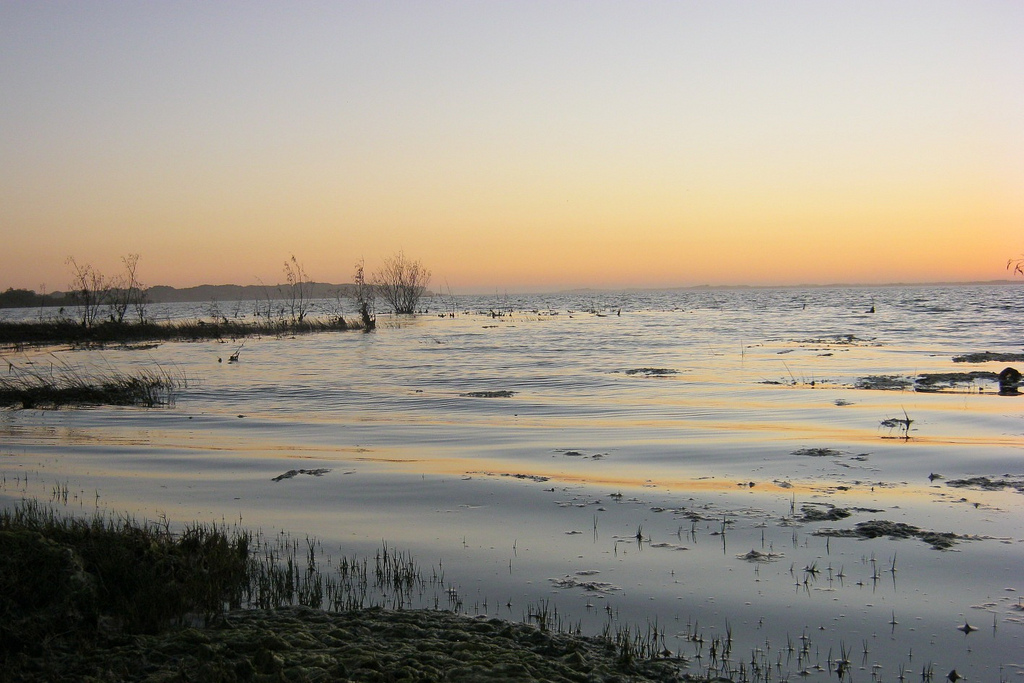 Bot River Estuary, Photo John Bradfield (internet)
Bot River Estuary, Photo John Bradfield (internet)
The Bot Estuary is an important nursery area for juvenile fish, is used for recreational angling, canoeing, skiing, swimming and birding and makes the towns of Kleinmond and Betty’s Bay a popular tourist destination.
The sustainability of these activities is dependent on a healthy estuary. The health of the Bot Estuary was affirmed by Mother Nature yesterday when a spectacular dark brown plume spurted out of the otherwise green ocean as a result of the breach of the Kleinmond mouth of the BotKleinmond estuarine system.
It is desirable for the Bot estuary to open every few years from a fisheries perspective as this natural phenomenon prevents the estuary from turning into a freshwater lake, threatening estuarine biodiversity. Mass mortalities of fish have occurred in the past when the salinity dropped below 6 parts per 1000 but it is currently about 12 parts per 1000.
As with most coastal areas, human activities in the Western Cape tend to concentrate along the coastline. This also concentrates a wide range of human activities that inevitably places strain on marine resources and ecosystems. These activities take place on land and in the ocean, and are both consumptive, such as fisheries, and non-consumptive, such as tourism.
An amount of R 186 million was allocated nationally by the Department of Environmental Affairs and Development Planning to Integrated Catchment Management for the financial periods 2013 -16. These funds would be spend on wetland rehabilitation, fire and alien management in our River Catchment Areas over three years. When the catchments are in good state, the healthy functio-ning of estuaries is greatly improved.
CapeNature receives R1. 4 million from Department of Environmental Affairs to spend specifically on estuary management in the province. In addition to this CapeNature staff spends time and travel costs to support estuary management forums and to assist with monitoring and research in estuaries. CapeNature staff also visit each estuary to audit structures built below the high tide mark. Each of these has a lease agreement with CapeNature in terms of the Sea Shore Act. There are over a thousand of these structures in estuaries in the Western Cape.
Why is estuary management important?
It is suggested that fish may recognize estuaries in which they grew up in. What is incredibly important is that young fish also "taste" this plume in the water and quickly enter the estuary. Here they grow up as there is plenty of food. When the estuary opens again they return to the ocean as large fish. They mature in the ocean and then breed. Their young then return to the same estuary to grow up. This is an essential cycle that needs to be maintained. Only healthy estuaries can maintain this cycle.
Estuary dependent marine species (young grow up in estuaries) like the Dusky Kob and White Steenbras are in dire straits and need healthy estuaries to survive. The estuarine pipe fish is an interesting inhabitant of the Bot Estuary. "Estuaries or the tidal mouth of large rivers are the scorecards of our catchments. If a catchment is not managed effectively the estuary and associated marine ecosystems will reflect this. In addition to the loss of biodiversity, all associated goods and services that an estuary has to offer are lost," said Cape Nature's Cape Estuaries Programme co-ordinator, Pierre De Villiers.
Estuaries form transition zones between rivers and oceans are critical for the support of various species in its ecosystem.
Several large cities are located on estuaries and they are often subjected to high levels of pollution which destroys the system. Overfishing and development can lead to the life in the estuary becoming unsustainable.
Anton Bredell, Minister of Local Government,
Environmental Affairs and Development Planning
Gansbaai Courant provides the Gansbaai community with the latest in news and interesting stories about and around the area.
View Profile
What is Xplorio?
Xplorio is your local connection allowing you to find anything and everything about a town.
Read More





 Bot River Estuary, Photo John Bradfield (internet)
Bot River Estuary, Photo John Bradfield (internet)





